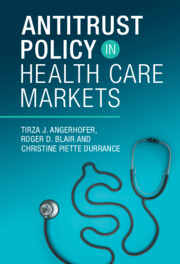Book contents
- Antitrust Policy in Health Care Markets
- Antitrust Policy in Health Care Markets
- Copyright page
- Dedication
- Contents
- Figures
- Tables
- Acknowledgments
- Table of Cases
- 1 Health Care Markets and Competition Policy
- 2 Antitrust Policy in the United States
- Part I Monopoly
- Part II Seller Cartels
- 6 Collusion in Health Care Markets
- 7 Collusion in Generic Drug Markets
- 8 The Hatch-Waxman Act, Patent Infringement Suits, and Reverse Payments
- 9 The Alleged Insulin Conspiracy
- 10 Licensing of Health Care Professionals
- Part III Monopsony
- Part IV Buyer Cartels
- Part V Mergers and Acquisitions
- Index
- References
9 - The Alleged Insulin Conspiracy
from Part II - Seller Cartels
Published online by Cambridge University Press: 24 November 2022
- Antitrust Policy in Health Care Markets
- Antitrust Policy in Health Care Markets
- Copyright page
- Dedication
- Contents
- Figures
- Tables
- Acknowledgments
- Table of Cases
- 1 Health Care Markets and Competition Policy
- 2 Antitrust Policy in the United States
- Part I Monopoly
- Part II Seller Cartels
- 6 Collusion in Health Care Markets
- 7 Collusion in Generic Drug Markets
- 8 The Hatch-Waxman Act, Patent Infringement Suits, and Reverse Payments
- 9 The Alleged Insulin Conspiracy
- 10 Licensing of Health Care Professionals
- Part III Monopsony
- Part IV Buyer Cartels
- Part V Mergers and Acquisitions
- Index
- References
Summary
In the United States, more than 10 percent of the population suffers from diabetes. For many, insulin stands between them and decidedly ill health or death. This makes the demand for insulin extremely inelastic. For many low-income diabetics, the cost of insulin accounts for a large fraction of their disposable income, which makes it difficult to pay rent, maintain a healthy diet, and provide for the needs of children and aging parents. As a result, it is important to preserve and promote competition in the insulin market. But the price of insulin continues to rise, indicating that insulin markets may not be competitive. We review two possible explanations. First, there have been allegations that pharmacy benefit managers, whose primary role is to negotiate lower pharmaceutical prices, may be encouraging higher insulin prices to increase rebates and their profits. Second, there have been allegations that the three major producers of insulin – Eli Lilly, Novo Nordisk, and Sanofi – have been cooperating rather than competing. This chapter addresses these allegations and the antitrust response.
- Type
- Chapter
- Information
- Antitrust Policy in Health Care Markets , pp. 204 - 229Publisher: Cambridge University PressPrint publication year: 2022

